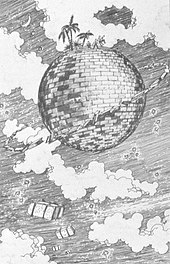
The concepts of space stations and space habitats feature in science fiction. The difference between the two is that habitats are larger and more complex structures intended as permanent homes for substantial populations (though generation ships also fit this description, they are usually not considered space habitats as they are heading for a destination[1]), but the line between the two is fuzzy with significant overlap and the term space station is sometimes used for both concepts.[2][3] The first such artificial satellite in fiction was Edward Everett Hale's "The Brick Moon" in 1869,[2][4] a sphere of bricks 61 meters across accidentally launched into orbit around the Earth with people still onboard.[1][5]
- ^ a b Cite error: The named reference
GreenwoodHabitatswas invoked but never defined (see the help page). - ^ a b Nicholls, Peter; Langford, David (2022). "Space Stations". In Clute, John; Langford, David; Sleight, Graham (eds.). The Encyclopedia of Science Fiction (4th ed.). Retrieved 2023-12-29.
- ^ Cite error: The named reference
SFEHabitatswas invoked but never defined (see the help page). - ^ Stableford, Brian (2006). "Artificial satellite". Science Fact and Science Fiction: An Encyclopedia. Taylor & Francis. pp. 35–37. ISBN 978-0-415-97460-8.
- ^ Fries, Sylvia Doughty; Ordway, Frederick I. III (1987-06-01). "The Space Station From Concept to Evolving Reality". Interdisciplinary Science Reviews. 12 (2): 143–159. doi:10.1179/isr.1987.12.2.143. ISSN 0308-0188.
© MMXXIII Rich X Search. We shall prevail. All rights reserved. Rich X Search
